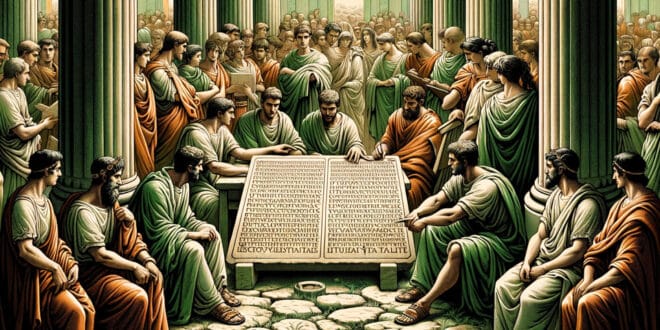Roman law laid the foundation for legislation throughout ancient civilization and subsequently became the bedrock upon which the legal thought of the Roman-Germanic peoples of Continental Europe was formed. These laws continue to be a mandatory subject of study at specialized universities worldwide, carrying unique philosophical, historical, and cultural significance.
The Laws of the Twelve Tables played a leading role in the development of Roman law. They were the first written code that regulated virtually all aspects of life in the urban community.
In particular, the Laws of the Twelve Tables defined family, inheritance, property, and monetary relations, the procedures for conducting judicial proceedings, and the punishments for committed crimes.
Page Contents
History of Origin
The creation of the Laws of the Twelve Tables is attributed to the mid-5th century BC. According to the accepted version, two commissions drafted this code. The first assembly, consisting exclusively of patricians, prepared ten norms based on the study of Greek law, which did not satisfy the needs of Rome’s plebeian population, leading to a sharp political conflict. As a result, a year later, a second commission was created, including representatives of the non-privileged class, which added two more provisions to the code.
Interestingly, the name “Laws of the Twelve Tables” came about because the texts of the legal norms were inscribed on exceptional wooden (or, according to some sources, bronze) tablets set up in the city’s main square (the forum) for public viewing. It was assumed that every citizen should memorize the code by heart, not deviating from their obligations due to ignorance of the law, which was intended to serve the prosperity and establishment of order in the state. Moreover, legal studies were considered a mandatory part of secular education and were taught in schools to children.
I recommend reading about: The Roman Forum
The originals of the Laws of the Twelve Tables have not survived to this day. Historians believe they were lost during the Gallic invasion in the 4th century BC. However, the text of the code, or rather individual provisions, was reproduced and systematized in the works of many Roman writers, scientists, and political figures, both in the form of exact quotations and free retellings.
General Characteristics
The Laws of the Twelve Tables reflected the level of legal consciousness in the ancient Roman era. Despite some remnants of patriarchal communities, plebeians gained formal equality with patricians in judicial proceedings. For any citizen defending their rights, regardless of their lineage or class affiliation, there was now the possibility to be guided by the letter of the law rather than conservative ancient customs.
Justice became the highest measure. A judge found guilty of bribery faced capital punishment. Similarly, punishments were severe for perjury and slander. The new code nullified special privileges; for instance, funeral expenses for nobles were limited to maintain equality. However, marriages between plebeians and patricians remained prohibited for a long time and were only allowed in 445 BC.
Special attention to the laws was paid to patriotic aspects. Betrayal of Rome’s interests in any form was strictly condemned, and the traitor was threatened with physical retribution.
The Laws of the Twelve Tables included mechanisms for making deals, contracts, and ways of resolving property disputes. Private land ownership was limited in nature and very vague in form: sales, gifts, and inheritance had to be conducted under community supervision, and only citizens could own and manage land.
Notably, a Roman who cultivated an unclaimed piece of land for two years was granted the right to own it. Trespassing on someone else’s property or evading debt repayment was harshly punished.
Interestingly, only the head of the family could manage the property, a relic of archaic society. According to the Laws of the Twelve Tables, he had unlimited authority over all household members (agnates), including the wife, children, and grandchildren. Thus, not every free person fully possessed civil and political rights.
Interesting Facts
Some provisions of the Laws of the Twelve Tables may seem strange or even barbaric from a modern perspective. Among the rules noted for their particular harshness are:
- It was permissible to kill newborns with deformities or injuries at birth.
- A legal age for marriage was established: 12 years for girls and 14 for boys.
- It was forbidden to bury or cremate the dead within the territory of urban lands.
- Women, even upon reaching adulthood, were required to have a guardian. An exception was made only for priestesses, in respect of their high status.
- The head of a family had the right to sell his sons.
- After marriage, a daughter lost the right to inherit her father’s property.
- With the consent of relatives, a husband could expel his wife from home, subject her to debt slavery, or take her life.
- A bride’s dowry became part of the family property she could not manage after marriage.
- Judicial proceedings were not to last more than one day, and it was forbidden to evade trials even in case of illness.
- Killing a thief caught at the crime scene at night was considered a lawful action.
- Chronic debtors faced a grim fate: they could be publicly dismembered.
- Destroying someone else’s crop was considered a grave sin and was punished more severely than killing a person.
- Death penalty was imposed on those who intentionally neglected boundary markers on a land plot.
- Interestingly, a free citizen who committed a crime had the opportunity to buy his way out, whereas enslaved people and foreigners paid for their actions with their lives.
What do you think? Which of the Roman laws would still be relevant today?
 Italy for me From Italy with love
Italy for me From Italy with love

